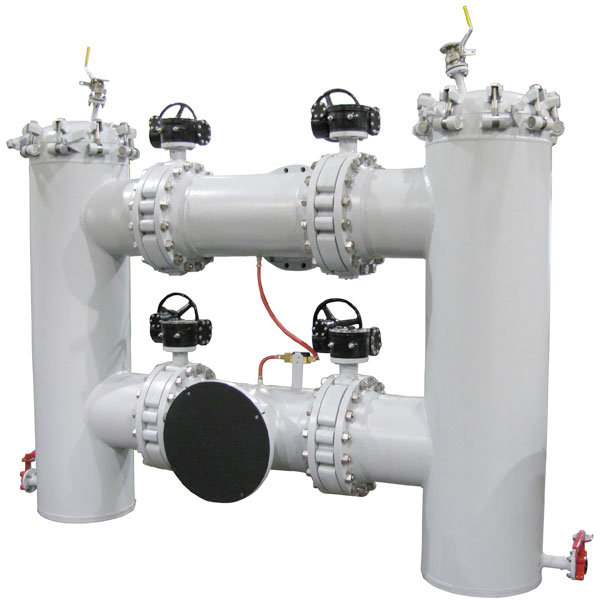If it looks like we’re showing off with this product profile, we are.
We found this photo in the archive and realised we had never featured it on the website, and frankly, this one deserved some publicity.
This is just one of those shiny special products with all the bells and whistles that you want to show off, like your first car, or smart phone depending on your age. Of course, if you’re thinking cars it would be one of those marvelous 1950 North American machines with big fins on the back and chrome everywhere. I think I might be showing my age here.

This unit is a 20 inch DBH150 fabricated dual basket strainer.
You can see the lug style butterfly valves with gears for isolation.
It is constructed from Class 150 carbon steel.
It uses Sure Flow Equipment’s Type Three – compact design with offset inlet and outlet.
You can see running between the two strainers a differential pressure gauge assembly, to allow operators to determine when cleaning is required.
When baskets need to be cleaned or replaced the unit includes flanged vents with quick open covers.
This unit was to be installed in a marine environment, so it included a special epoxy external coating. The tough operating environment is also recognizable with the unit utilizing stainless steel bolting.
Did we mention bells and whistles?
This fabricated unit includes flanged vents with balls valves, and flanged drains with butterfly valves.
The vents on the covers of this unit are for bleeding off pressure before opening the covers for cleaning or whatever other reason that may require the cover to be opened. Vents such as this are also helpful to remove air as they fill the line and strainers with fluid. As the fluid enters the strainer, air is pushed out through the open vent.
The drains are for removing the fluid from the strainer housing. Sometimes it is beneficial to remove some fluid when removing the basket. This can reduce any pull or vacuum encumbrance that a full strainer would exert during basket removal.
Also, should the line where this dual basket strainer is installed ever have to be completely drained, say if the facility is on shutdown, the drains allow the unit to be completely emptied.
While specific customers and processes may have other uses for drains and vents, these would be the most common.
Normally the vents and drains would have the same valve, or same type of valve. They may be a different size based on their location, but in most of our custom fabricated dual basket systems like this, they’d be the same.
The drain valve is generally larger than the vent valve to allow the unit to be drained in a timely fashion, whereas the vent only has to relieve pressure. In most of our dual basket strainers they would both be ball valves.
In this case, which is fairly rare, our customer required butterfly valves for the drains.
We are always happy to design and custom fabricate products like this to our customers’ specifications.
In this case our design and fabrication team were exceptionally happy with the final product, and we’re happy we finally got to show it off.

